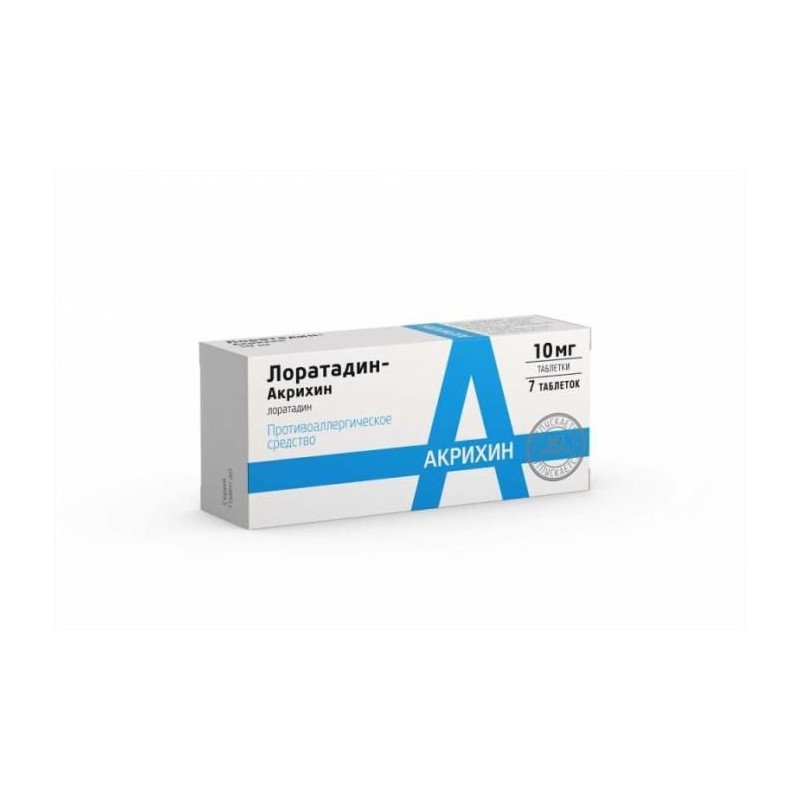



 All payments are encrypted via SSL
All payments are encrypted via SSL
 Full Refund if you haven't received your order
Full Refund if you haven't received your order
Loratadine - a blocker of histamine H1 receptors (long-acting). Inhibits the release of histamine and leukotriene C4 from mast cells. Prevents the development and facilitates the course of allergic reactions. It has antihistamine, antiallergic, antipruritic and anti-exudative action. Reduces capillary permeability, prevents the development of tissue edema, relieves spasm of smooth muscles. The antiallergic effect develops after 30 minutes, reaches a maximum after 8 to 12 hours and lasts 24 hours. It does not affect the central nervous system and does not cause addiction (because it does not penetrate the blood-brain barrier).
Quickly and completely absorbed in the digestive tract. Tmax - 1.3-2.5 h; eating slows it down for 1 hour. Cmax in elderly people increases by 50%, with alcoholic liver damage, depending on the severity of the disease. Communication with plasma proteins - 97%. Metabolized in the liver to form the active metabolite of descarboethoxyloratadine with the participation of cytochrome P450, CYP3A4 and, to a lesser extent, CYP2D6 isoenzymes. Equilibrium concentration of loratadine and metabolite in plasma is achieved on the 5th day of administration. Does not penetrate the BBB. T1/2 loratadine - 3-20 hours (average 8.4 hours), active metabolite - 8.8-92 hours (average 28 hours); in elderly patients, respectively - 6.7-37 hours (average 18.2 hours) and 11-38 hours (17.5 hours). When alcoholic liver damage T1/2 increases with the severity of the disease. Excreted by the kidneys and with bile. In patients with chronic renal failure and during hemodialysis, the pharmacokinetics are virtually unchanged.
- seasonal and perennial allergic rhinitis (including pollinosis);
- allergic conjunctivitis;
- urticaria (including chronic idiopathic);
- Quincke swelling;
- allergic pruritic dermatosis;
- pseudo-allergic reactions;
- allergic reactions to insect bites;
- itching of various etiologies.
Inside Adults and children over 12 years old: 10 mg (1 tablet) 1 time / day. Daily dose of 10 mg.
Children from 3 to 12 years on 5 mg (1/2 tablets) 1 time / day. Daily dose - 5 mg.
Children weighing over 30 kg - 10 mg of the drug 1 time / day. Daily dose - 10 mg.
The adverse events listed below with loratadine were observed with a frequency of> 2% and about the same frequency as with placebo (“pacifiers”).
In adults: headache, fatigue, dry mouth, drowsiness, gastrointestinal disorders (nausea, gastritis), as well as allergic reactions in the form of a rash. In addition, there were rare reports of anaphylaxis, alopecia, abnormal liver function, palpitations, and tachycardia.
In children seldom: headache, nervousness, sedative effect.
- hypersensitivity;
- pregnancy, lactation;
- children's age up to 3 years.
Carefully: liver failure.
Contraindicated in pregnancy, during lactation;
Carefully: liver failure.
Contraindicated in children up to 3 years.
Influence on ability to drive motor transport and control mechanisms
During the period of treatment, it is necessary to refrain from engaging in potentially hazardous activities that require increased concentration of attention and quickness of psychomotor reactions.
Symptoms: drowsiness, tachycardia, headache. In case of overdose, consult a doctor.
Treatment: induction of vomiting, gastric lavage, reception of Activated carbon.
Ethanol reduces the effectiveness of loratadine.
Erythromycin, cimetidine, Ketoconazole, when used together with loratadine, increase the concentration of loratadine in the blood plasma, without causing clinical manifestations and without affecting the ECG.
Inductors of microsomal oxidation (phenytoin, barbiturates, zixorin, rifampicin, phenylbutazone, tricyclic antidepressants) reduce the effectiveness of loratadine.
List B. Keep out of reach of children, dry and protected from light, at a temperature not exceeding 25 ° C.
